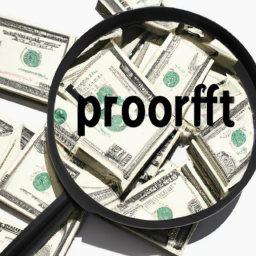Have you ever wanted to start a blog but weren’t sure where to start? Well, let me tell you that finding a profitable niche is crucial for successful blogging. You want to choose a topic that you’re passionate about and that you want to share with others. But how do you know if your niche is profitable? Don’t worry, I’ll break it down for you.
First, start by brainstorming topics that you love and that you think others would be interested in. Consider your personal and professional interests, hobbies, and ongoing projects. Once you have a few ideas, it’s time to validate your niche using a 3-step process.
The first step is to check the size of the niche. Is there a demand for this topic? Are people searching for it? Use keyword research tools to determine the search volume for your niche.
Next, explore your competitors. Are there other bloggers or websites covering the same topic? This can give you an idea of how popular the niche is and if there is room for you to enter the market. Don’t be discouraged by competition, they can also become potential collaborators.
Lastly, analyze the monetization potential of your niche. Are other bloggers selling related products or services? Are businesses advertising in your niche? Are there affiliate offers available? This will give you an idea of how you can make money from your blog.
By applying this validation process to all your niche ideas, you can make a final decision on which one to pursue. Then, create a solid blog strategy and start your new blog, focusing on your chosen niche. In my upcoming article, I’ll go into more detail on each step of the validation process, so stay tuned!
Finding a Profitable Niche for Successful Blogging
Finding a profitable niche is crucial for successful blogging. As a blogger, it is important to choose a topic that not only interests you but also has the potential to attract a large audience and generate revenue. In this article, I will share a step-by-step guide to help you find a profitable niche for your blog.
Brainstorming Topics
The first step in finding a profitable niche is to brainstorm topics that you are passionate about and want to share with others. Think about the things that you enjoy doing in your free time or the subjects that you have knowledge and expertise in.
Identify your passions
Start by identifying your passions. What are the things that make you excited and eager to learn more? Maybe you are passionate about cooking, fitness, or personal finance. These could be potential niches for your blog.
Consider personal and professional interests
Along with your passions, consider your personal and professional interests. Are there any topics that are related to your field of work or areas of expertise? Sharing your knowledge and experiences in these areas can help you establish yourself as an authority in your niche.
Explore hobbies
Don’t forget to explore your hobbies. Hobbies are a great source of inspiration for blog topics. Whether you are into gardening, photography, or DIY crafts, there is likely an audience out there who shares your interests and would love to read your blog.
Evaluate ongoing projects
Lastly, evaluate any ongoing projects that you are currently working on. Are there any aspects of these projects that could be turned into a niche for your blog? For example, if you are currently renovating your home, you could start a blog about home improvement and share your experiences and tips with others.
Validation Process
Once you have brainstormed potential niche ideas, it’s time to validate them. This involves checking the niche size, exploring competitors, and analyzing the monetization potential.
Check niche size
Begin by checking the size of your niche. Is there a large enough audience interested in the topic you have chosen? Conducting market research and analyzing search trends can give you insights into the size of your potential audience.
Explore competitors
Next, explore the competition in your niche. Research existing blogs and websites that cover similar topics. Look at their content, audience engagement, and social media following. While competition may seem discouraging, remember that they can also become potential collaborators and sources of inspiration.
Analyze monetization potential
Lastly, analyze the monetization potential of your niche. Look for other bloggers in your niche who are selling related products or services. This indicates that there is a market demand for such offerings. Additionally, find out if businesses advertise in your niche or if there are affiliate offers available. These factors can help you gauge the potential for generating revenue from your blog.
Using Keyword Research Tools
Keyword research tools are invaluable when it comes to finding a profitable niche. They can provide you with insights into the search volume for your chosen topic and help you identify popular keywords that can drive organic traffic to your blog.
Determine search volume for your niche
Use keyword research tools to determine the search volume for your niche. This will give you an idea of how many people are searching for information related to your niche. Aim for a niche with a decent search volume to ensure a steady stream of potential readers.
Identify popular keywords
Keyword research tools can also help you identify popular keywords within your niche. These are the terms and phrases that people commonly search for. By incorporating these keywords into your blog content, you can increase your chances of ranking higher in search engine results and attracting more organic traffic to your blog.
Evaluating Competitors
Analyzing your competitors is an important step in finding a profitable niche. It allows you to understand what is already out there and gives you the opportunity to learn from their strategies and content.
Research existing blogs in your niche
Start by researching existing blogs in your niche. Take a look at their content, writing style, and topics covered. Pay attention to their audience engagement and social media presence. This will give you an idea of what works well in your niche and what you can do differently to stand out.
Identify potential collaborators
While competitors may seem like a threat, they can also become potential collaborators. Look for bloggers in your niche who share a similar target audience but offer complementary content. Collaborating with them can help you expand your reach and tap into their existing audience.
Analyze their strategies and content
Lastly, analyze the strategies and content of your competitors. What types of blog posts are they publishing? Are they utilizing social media effectively? How do they monetize their blogs? By studying their approach, you can gain valuable insights and find inspiration for your own blog.
Analyzing Monetization Potential
Understanding the monetization potential of your niche is crucial for building a successful blog. Here are some ways to analyze the monetization potential of your chosen niche.
Look for bloggers selling related products or services
One way to gauge the monetization potential is to look for other bloggers in your niche who are selling related products or services. If there are successful bloggers already monetizing their blogs in this way, it indicates that there is a demand for such offerings in your niche.
Find out if businesses advertise in your niche
Another indicator of monetization potential is if businesses advertise in your niche. Research if there are businesses that are willing to invest in advertising to reach your target audience. This shows that there is a market for your niche and potential opportunities for sponsored content or collaborations.
Check for available affiliate offers
Lastly, check if there are available affiliate offers in your niche. Affiliate marketing is a popular way to monetize a blog, where you earn a commission for promoting products or services. Look for affiliate programs and networks that align with your niche and check if there are suitable offers for you to promote.
Applying the Validation Process
Now that you have gathered information about your potential niches, it’s time to apply the validation process to narrow down your options.
Evaluate niche ideas based on size, competition, and monetization
Evaluate each niche idea based on its size, competition, and monetization potential. Consider the size of the audience it attracts, the competition you will face, and the potential revenue streams. Rank your ideas based on these factors and choose the one that offers the best balance.
Narrow down options
Once you have evaluated and ranked your niche ideas, narrow down your options to a few top choices. Consider factors such as your level of interest and expertise, the potential for growth and revenue, and the ability to differentiate yourself from your competitors. Choose the niche that feels the most compelling and aligned with your goals.
Creating a Blog Strategy
Now that you have chosen a profitable niche, it’s time to create a blog strategy. A solid strategy will guide your content creation, audience targeting, and overall branding.
Define goals and target audience
Start by defining your goals. What do you want to achieve with your blog? Is it to establish yourself as an expert, generate income, or simply share your knowledge? Once you have defined your goals, identify your target audience. Who are they? What are their needs and desires? Understanding your audience will help you create content that resonates with them.
Develop content plan
Next, develop a content plan. Outline the topics you want to cover and create a content calendar to ensure a consistent posting schedule. Research and brainstorm ideas for blog posts that provide value to your audience. Incorporate popular keywords and trends in your content to increase its visibility in search engine results.
Establish a unique selling proposition
Differentiate yourself from your competitors by establishing a unique selling proposition (USP). What makes your blog different? What value do you offer that others don’t? Communicate your USP clearly to your audience, whether it’s through your writing style, expertise, or the format of your content.
Starting Your Blog
With a solid blog strategy in place, it’s time to start your blog. Here are some steps to follow when starting your new blog.
Choose a platform and set up your blog
Choose a blogging platform that suits your needs, such as WordPress, Blogger, or Squarespace. Set up your blog by selecting a domain name and hosting provider. Customize the layout, theme, and design elements to create a visually appealing website that reflects your brand.
Design an appealing website
Design an appealing website that is easy to navigate and visually appealing. Use high-quality images and graphics that are relevant to your niche. Optimize your website for mobile devices to ensure a seamless user experience across different screens.
Develop a consistent brand image
Establish a consistent brand image for your blog. Choose colors, fonts, and visual elements that align with your niche and resonate with your audience. Use your brand consistently across your website, social media profiles, and marketing materials to create a cohesive and recognizable presence.
Focusing on Your Chosen Niche
Now that your blog is up and running, it’s time to focus on your chosen niche. Here’s how you can grow and engage with your audience.
Research and publish niche-specific content
Research and publish niche-specific content that provides value to your audience. Stay up to date with the latest trends and developments in your niche and share your insights and expertise. Experiment with different types of content, such as blog posts, videos, infographics, or podcasts, to cater to different preferences.
Engage with your target audience
Engage with your target audience by encouraging comments, responding to messages, and participating in relevant discussions on social media or online forums. Build relationships with your readers and establish yourself as a trusted source of information in your niche.
Continuously improve and adapt
Continuously improve and adapt your blog based on feedback and analytics. Monitor your website traffic, engagement metrics, and conversion rates to identify areas for improvement. Experiment with new strategies, such as guest posting, email marketing, or collaborations, to expand your reach and attract new readers.
Conclusion
Finding a profitable niche is essential for successful blogging. By following the steps outlined in this article, you can identify a niche that aligns with your passions and has the potential to attract a large audience and generate revenue.
Remember to brainstorm topics based on your passions, personal and professional interests, hobbies, and ongoing projects. Validate your niche by checking its size, exploring competitors, and analyzing its monetization potential. Use keyword research tools to determine search volume and popular keywords. Analyze competitors and learn from their strategies and content.
With a well-defined niche in mind, create a blog strategy that defines your goals, target audience, and content plan. Start your blog by choosing a platform, designing an appealing website, and establishing a consistent brand image. Focus on your chosen niche by researching and publishing niche-specific content, engaging with your target audience, and continuously improving and adapting.
By following these steps, you can increase your chances of building a successful blog and establishing yourself as an authority in your chosen niche. Good luck!
Disclosure: My content is reader-supported. If you click certain links, I may earn a commission at no extra cost to you. Your support helps keep my blog running. Learn more about my funding and editorial process.







